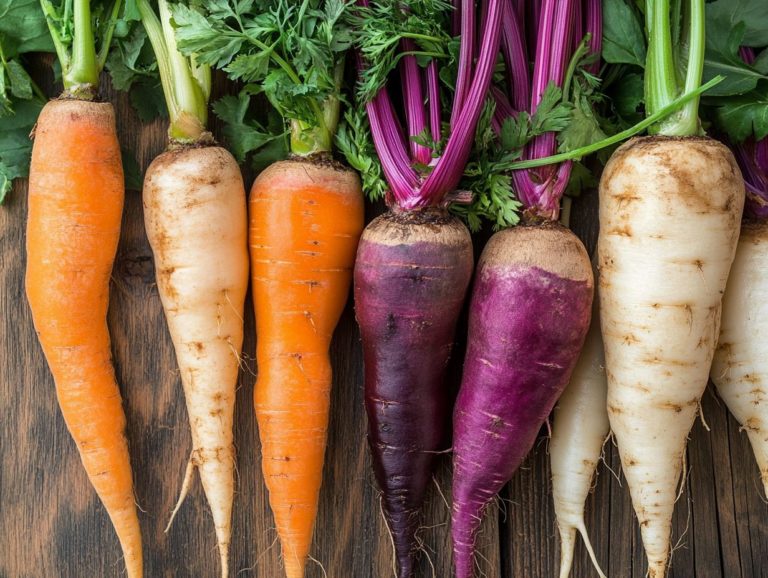Common Wild Herbs: Identification Tips
Wild herbs are nature s hidden treasures, brimming with flavor and remarkable medicinal properties. They offer a delightful and nutritious buffet for those interested in foraging. Join us in this adventure!
In this guide, you ll discover how to identify common wild edible plants, such as dandelion and stinging nettles, by examining their unique characteristics. You ll learn to distinguish them from their lookalikes.
You ll also discover effective harvesting techniques and creative ways to incorporate these plants into your cooking and natural remedies. With essential safety tips included, you can enjoy a worry-free foraging experience while exploring aquatic plants like cattails and arrowheads.
Embark on this journey to unlock the secrets of wild herbs and elevate your culinary adventures by using a simple method to check if a plant is safe to eat!
Contents
- Key Takeaways:
- What are Common Wild Herbs?
- Identifying Common Wild Herbs
- Discover the Exciting World of Common Lookalikes and How to Distinguish Them
- Harvesting and Using Common Wild Herbs
- Safety and Precautions
- Frequently Asked Questions
- What are some common wild herbs and how can I identify them?
- What are some tips for identifying wild herbs?
- Can I use my sense of smell to identify wild herbs?
- Are there any poisonous wild herbs that I should be aware of?
- What are some tools that can aid in identifying wild edible plants and ensure safe foraging practices?
- Can I Use Wild Herbs for Cooking or Medicinal Purposes? (e.g., Rosa multiflora and Japanese honeysuckle)
Key Takeaways:

- Learn to identify common wild edible plants, such as Rosa multiflora and Japanese honeysuckle, by their physical traits to avoid harmful plants.
- Learn harvesting techniques that respect nature and keep you safe while cooking with wild plants.
- Be aware of potential risks from poisonous plants, and take precautions to ensure your safety and well-being.
What are Common Wild Herbs?
Common wild edible plants are crucial for foraging in North American forests. They offer nutritious options and play an important role in traditional medicine and sustainable living.
These often-overlooked plants can elevate your diet. Edible plant expert Andrew Townesmith highlights their significance for sustainable living and essential survival skills.
Identifying Common Wild Herbs
To identify common wild edible plants in North America, you need a keen eye. Familiarizing yourself with their traits is vital for successful foraging, as these plants can be tricky.
Understanding their distinct characteristics and applying the universal edibility test are essential for ensuring safety. Experts like Andrew Townesmith and the United Plant Savers strongly advocate for this approach.
Physical Characteristics and Features
The physical characteristics of wild herbs vary significantly. Many can be identified by their unique features, such as leaf shape, flower color, and growth patterns. Learning about edible plant identification key features can help you recognize them during your foraging adventures.
For instance, some herbs display whorled leaf arrangements, like Arctium minus, which can be distinguished from those with alternate or opposite structures. The intricate flower forms from tubular to star-shaped often indicate specific species like Himalayan blackberries and their preferred habitats in wooded areas or open fields.
If you’re eager to identify these wild edible plants, explore the extensive resources at the Missouri Botanical Garden. They provide valuable information on culinary and medicinal uses, enhancing your understanding and guiding both novice and experienced foragers on their botanical journey.
Ready to embrace the wild? Let s begin foraging today!
Discover the Exciting World of Common Lookalikes and How to Distinguish Them

Understanding common lookalikes of wild edible plants is essential for you as a forager. For example, the toxic lily of the valley can easily be mistaken for wild garlic, especially in early spring. This is crucial knowledge; it can mean the difference between a delicious meal and a trip to the hospital due to poisonous plants!
To confidently distinguish between these plants, pay attention to variations in leaf texture, color nuances, and scent. Always use the universal edibility test when in doubt. For more insights, consider these essential tips for plant identification. The habitats they prefer are also telling: wild garlic thrives in damp, shady areas, often found alongside other wild edible plants.
These distinctions are crucial for safe foraging. They also highlight broader survival principles, reinforcing teachings from the Chestnut School of Herbal Medicine.
Harvesting and Using Common Wild Herbs
Harvesting common wild edible plants is about more than just collecting; it s essential to understand their culinary and medicinal applications to enhance your dishes. This journey is best navigated by following the principles established by foraging expert Andrew Townesmith and utilizing valuable resources like survival guides.
Proper Harvesting Techniques
Proper harvesting techniques are vital for ensuring the health of our ecosystems. When you gather nutritious ingredients such as tree nuts, it’s crucial to protect the environment.
Consider the optimal time of year for harvesting. Align with the growth cycles of plants like pinyon pine and hickory nuts. Early mornings or late afternoons are ideal for collecting herbs, as they are most potent during these times, holding maximum moisture and aroma, especially in plants like nettles and blackberries.
Use the right tools, like sharp shears or scissors, to minimize damage to the plants. This helps preserve their root systems for future growth, allowing plants like acorn and raspberry to thrive.
By adhering to sustainable foraging practices, such as taking only what you need and ensuring enough remains for wildlife, you promote a healthy balance. This enhances biodiversity and sustainability in wild food sources.
Uses in Cooking and Medicine
Wild edible plants offer a remarkable array of nutritional benefits and versatile uses in both cooking experiences and traditional medicine. They are essential assets for foragers and food enthusiasts alike.
These often-overlooked plants enrich your cooking with distinctive flavors and enticing aromas. They serve as a wellspring of medicinal properties that can elevate your everyday health practices. Imagine nourishing dishes crafted with fresh nettles, aromatic teas brewed from chamomile, or desserts featuring blackberries this treasure trove of nature invites your exploration!
By mastering preparation methods like drying, steeping, or incorporating them into marinades you can unlock the full potential of these herbs. Understanding their therapeutic benefits can create a deep connection between your kitchen and wellness journey.
Embracing wild edible plants allows you to harness their power in your daily life. Transform your meals and health practices into something extraordinary and nutritious!
Now that you know the basics, grab your gear and start your foraging adventure!
Safety and Precautions

Safety and precautions are essential when foraging for wild edible plants, especially in North American forests. A thorough understanding of the risks linked to unfamiliar species is crucial to avoid dangerous encounters with poisonous plants like poison hemlock or foxglove.
By educating yourself, especially through reliable survival guides, you not only protect your health but also enhance your foraging experience, ensuring it remains both enjoyable and safe.
Potential Risks and How to Avoid Them
The potential risks of foraging include the possibility of misidentifying plants, encountering poisonous species, and facing health issues due to improper harvesting or preparation methods, especially when dealing with aquatic plants.
You may also face additional risks such as exposure to environmental hazards or allergic reactions to specific plants like the Albizia julibrissin. To mitigate these concerns, it’s essential to learn as much as you can about the local flora, including the wild edible plants in your area.
Spending time reading trusted survival guides and attending workshops can provide insights into foraging practices and the uses of various wild edible plants.
Joining local foraging groups can offer invaluable hands-on experience and provide a platform for sharing knowledge with seasoned foragers and food enthusiasts alike. Make sure to bring a field guide for a fun adventure! Don’t miss out on the chance to harvest nature’s treasures safely!
Frequently Asked Questions
What are some common wild herbs and how can I identify them?
Some common wild edible plants include dandelion, stinging nettles, plantain, and chickweed, which are all accessible during foraging. To learn more about these herbs and their unique identification features, check out the basics of foraging: identifying edibles. It’s essential to apply the universal edibility test, a method to determine if a plant is safe to eat.
For example, dandelion leaves have a jagged edge and a yellow flower, while nettle leaves have a serrated edge and a stinging sensation when touched, making them memorable for foragers.
What are some tips for identifying wild herbs?

One tip for identifying wild herbs is to observe the plant’s growth pattern. Some, like Rosa multiflora, may trail, while others grow upright. For more detailed guidance, check out this resource on how to identify common wild edibles. Some herbs grow in a rosette shape, while others, such as chickweed, have a more upright growth, a characteristic crucial for identification.
You can also look for specific features such as hairiness, spines, or distinctive flowers to help with identification, especially in the case of plants like the Castanea species.
Can I use my sense of smell to identify wild herbs?
Yes, your sense of smell can be a helpful tool in identifying wild edible plants, such as mint and yarrow. For example, mint has a distinctively strong and refreshing scent, while yarrow has a more subtle and earthy smell, providing hints that can aid in proper identification.
However, it is important to be cautious when using smell as an identifying factor, as some herbs may have a similar scent, leading to misidentification.
Are there any poisonous wild herbs that I should be aware of?
Yes, there are wild edible plants that can be toxic if consumed, which is why careful identification is crucial. Some common examples of poisonous plants include poison hemlock, nightshade, and foxglove, all of which can pose serious risks during foraging.
When foraging for wild edible plants, it is important to properly identify them and research their potential toxicity before using them, ensuring your safety on culinary adventures.
What are some tools that can aid in identifying wild edible plants and ensure safe foraging practices?
A field guide, magnifying glass, and plant identification apps are all helpful tools for identifying wild herbs. For those interested in expanding their knowledge, using a resource like the Finding Wild Herbs: Seasonal Foraging Guide can provide detailed descriptions, photographs, and even uses for different herbs in your local area.
Can I Use Wild Herbs for Cooking or Medicinal Purposes? (e.g., Rosa multiflora and Japanese honeysuckle)
Yes, many wild herbs can be used in cooking and medicine. It’s crucial to identify the herb correctly; this means knowing exactly what the herb is before consulting a professional.
Some herbs can interact with medications or cause allergies. Always do your research before using them to ensure you’re safe and informed!






